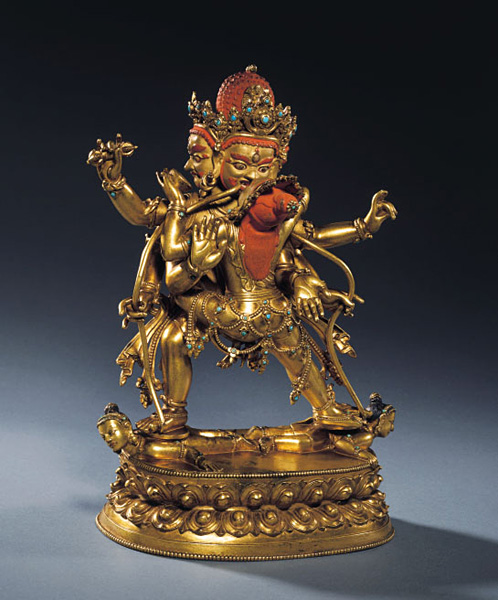|

The Bodhisattva Vajrapani is the compassionate patron of the teachings of Buddha, his fierce appearance is one of a powerful protector and remover of obstacles for mankind. He is the holder of the vajra (thunderbolt scepter) which symbolises the power of compassion. In his erotic tantric form of Mahacakra the deity has three faces and six arms and is considered to be associated with the subduing of the Nagas (snakes/serpent-like dragon beings).
Portrayed with three heads and six arms, Vajrapani is depicted in yab-yum, engaged in sexual union with his consort and holds a vajra in his raised right hand. Two hands hold the body of a snake as two of his main hands are pointed to the front, making the gestures of abhaya mudra, the pose of protection and fearlessness, and varada mudra, extended down conferring grace and charity. On his head, the Bodhisattva wears a five leaf crown and is adorned with earrings (snakes), bracelets, anklets, pearl decorated skirts, scarves, jewel girdles and ornaments. Snakes writhe in and out of his mouth and his finely curled and flaming hair is tied up into a high chignon in which a small image of Vajrapani is depicted. Resembling her consort, Vajrapani's female partner is righly adorned and bears an urna on her forehead, the sign of great being. She offers a blood filled scull cup in her left hand and wields a kartrika (tantric chopper) in her right. The couple is supported by sun-discs beneath their feet as a stabilising platform and trample on flattened demon-bodies who represent ignorance and evil spirits. The group is depicted on a double lotusthrone, the edges finely decorated with a strand of pearls.
The heavy superb casting in copper alloy and the fine yellowish gilding of this bronze reflect the technical skills and artistic imagination of the Nepalese newari craftsmen during the Malla kingdom period. Typical characteristics are the articulated stylistic elements like the five-leaf crowns, skirts, jewellery and ornaments as well as the pronounced double lotusthrone. The tantric icon, the traces of polychrome on the faces, hair, feet and hands as well as the original seal depicting a Vishvavajra at the bottom are all characteristic for a bronze being originally used in a Tibetan monastery, most likely from a south-central (Tsang) origin.
The representation of Mahacakrava Vajrapani is captured in a well modelled and inspired composition, revealing an intensive and restrained energy which radiates from this dynamic tantric group. The harmonious balanced union of the fierce erotic couple is complemented by convincing natural volumes, finely articulated details and powerful positioning of body, legs and arms. The snake passing through the deity's mouth increases the vigour and intensity of the couples presence. Striking are the positions of both demons with their heads sticking out of the base. The image is a wonderful example of Tibetan tantric art and is superb from all angles comprising the powerfully conceived back and profiles.
Published: Ulrich von Schroeder, Indo-Tibetan bronzes, Hong Kong 1981, nr. 124E, page 453.
Provenance: Collection Philip Goldman, London.
|

